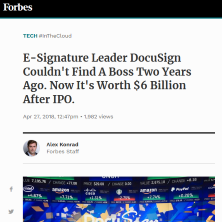 E-Signature Leader DocuSign Couldn’t Find A Boss Two Years Ago. Now It’s Worth $6 Billion After IPO.
E-Signature Leader DocuSign Couldn’t Find A Boss Two Years Ago. Now It’s Worth $6 Billion After IPO.
For e-signature leader DocuSign, a fifteen-year slog has turned into a big first day on the public markets in its IPO.
DocuSign enjoyed a successful first day of trading on Nasdaq on Friday, with shares trading at 39.70, up almost 37% from its list price of $29. That follows the company upping its expected price target multiple times as DocuSign raised $629 million from investors in the offering.
“We are super-excited, as this has been a long time coming,” says CEO Dan Springer, who was brought in to lead the company in January 2017. “We are focusing on building going forward and continuing to drive great success.”
At first look, DocuSign appears to be a story of decelerating growth, in part a victim of its own success, but also a story of increasingly profitable operations. DocuSign took in revenue of $581.5 million in its fiscal 2018 ending in January, up 35.9% from its 2016 totals. That’s slower growth than the previous year, when DocuSign increased revenue by 52%. But losses have shrunk over that period, from $115.4 million in 2016 to $52.3 million last year.
Springer says that the company doesn’t agree its growth is slowing. While he touted that the company was cash flow positive for the past year, he says customer expansion remains DocuSign’s priority in its five-year plans. “You will see us really put our focus in not improving the bottom line, but the top line,” says Springer. “We joke around here that our top three priorities here are growth, growth and growth.”
With billings up 39% for fiscal 2018, just ahead of revenue, DocuSign’s pipeline may be expanding, but investors are likely as excited, if not more, about what CFO Michael Sheridan tells Forbes will be a projected 20% to 22% operating margin five years from now.
With a share price of about $39.70, where DocuSign was trading midday on Friday, the company would be valued at about $6 billion, well above its last private valuation of $3.2 billion in 2015. That represents a big win for DocuSign’s early investors, some of whom have held their positions for well over a decade. Frazier Technology Ventures led the company’s Series A back in 2004, followed by a Series A extension including Ignition Venture Partners and a Series B led by Sigma Partners in 2006. At the time of the IPO, Sigma owned 12.9% of DocuSign, followed by Ignition with 11.7% and Frazier at 7.2%. DocuSign didn’t hit “unicorn” status, or a billion-dollar valuation, until 2014, according to a report from EquityZen.
Read more here: https://www.forbes.com/sites/alexkonrad/2018/04/27/docusign-ipo/#7260921e63b1
